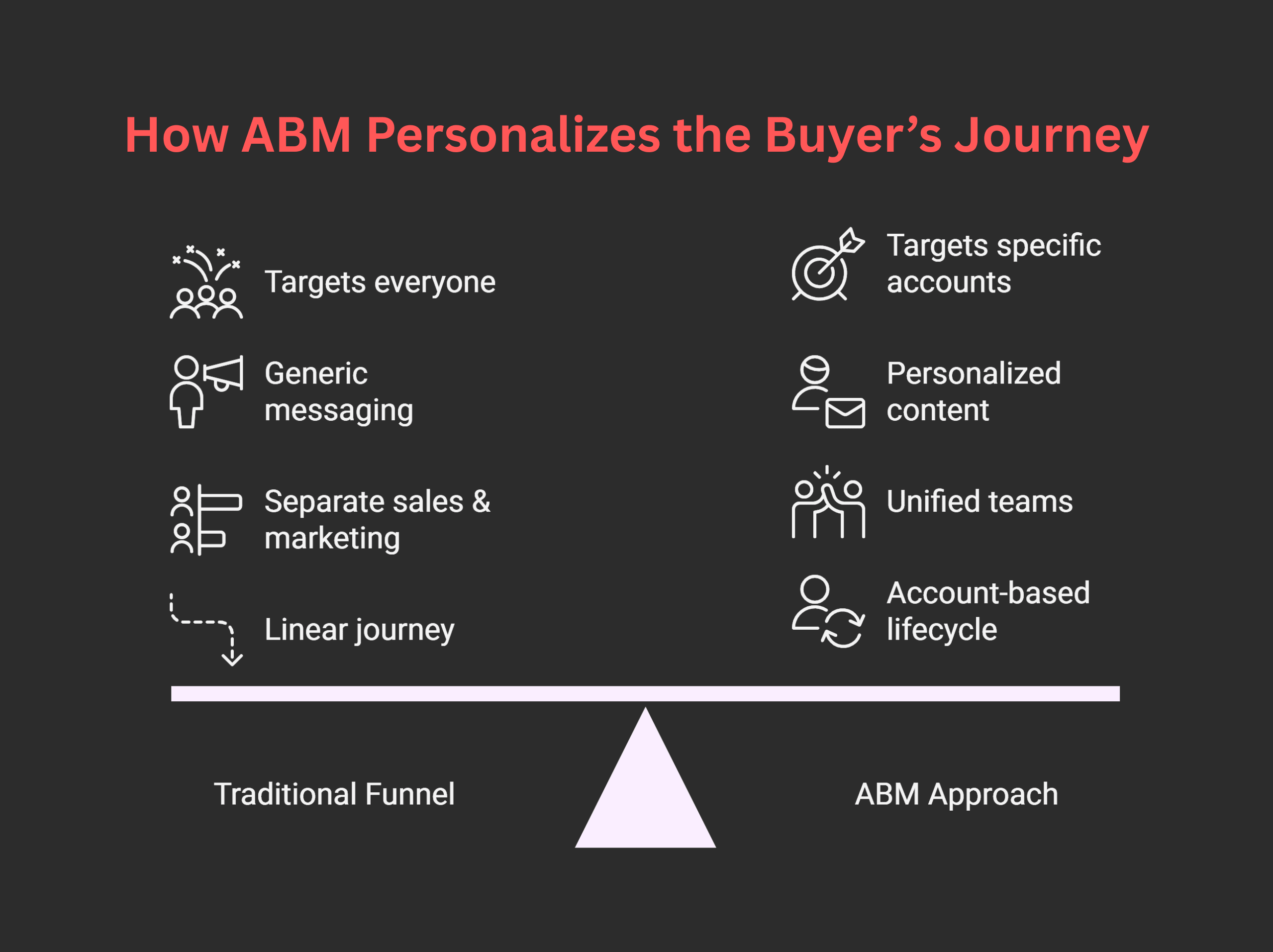8 Ways to Measure Account-Based Marketing That Impacts Revenue
Track ABM performance with 8 key analytics—from funnel engagement to conversions—to boost ROI and fix campaign gaps effectively.

The criticality of Account-Based Marketing for B2B businesses is immense; it involves customer acquisition & retention, engaging them through omnichannel marketing & generating sales conversions & afterwards delighting them for future prospecting & positive word-of-mouth.
ABM is an amalgamation of strategic approaches to business marketing based on the awareness of a particular account, wherein, the marketers target the enterprise level organizations to accomplish the following goals:
- Increase relevant content for target accounts & optimize the customers experiences
- Engage with specific leads at an earlier phase in their buying cycles, expediting conversions
- Align marketing & sales strategies to best suit the needs of the accounts & thereby reducing the length of the sales funnel
- Focusing on developing highly targeted marketing strategies
- Attract, engage & entice customers to take quicker buying decisions by developing compelling content
- Identify key decision makers associated with a particular account & within a particular operational niche & educate them about the value of specific products & services & how they can be leveraged to solve the pain-points of buyer persona, lies at the very heart of conversion rate optimization (CRO)
According to SiriusDecisions, 92% of B2B marketers, globally, consider ABM extremely or very important to their overall marketing efforts.
ABM integrated with inbound marketing practices generates the best results for companies, as specific decision makers within a company are targeted as opposed to only inbound marketing which targets all the people within a company.
An integrated ABM strategy well-orchestrated with the sales & marketing team & by employing data from omnichannel (viz. the demographic, firmographic, psychographic, fit-data & technographic data) helps the B2B marketers achieve their goal of Conversion Rate Optimization (CRO).
Measuring Account-Based Marketing is essential as it grows, so as to align it with the core objective of an increased Return on Investment (ROI) for B2B marketers. This starts with Account-Based Analytics which encompasses executive level revenue reporting, omnichannel reporting & campaign analysis.
Clearly, measuring ABM is imperative to optimize it, figure-out the loopholes that exist in the marketing endeavors & fix them to add to the ultimate goal of revenue optimization for B2B marketers.
Approaches towards Account-Based Analytics:
The ABM funnel can be divided into two parts based on (a) Customer acquisition (new business) & (b) expansion (customer marketing).
Once the leads are mapped specific to an account, the marketing team can:
- Fetch useful insights from each stage of the buyers’ cycle
- Allow introspection into whether key account personas have been reached which would allow the accounts to be closed
- Measure how many accounts are engaged at the top, mid & bottom level of the buyers’ cycle & how they can be optimized
- Understand what is the average time taken for the touch points to generate conversions, from the time they are first contacted?

When it comes to Account-Based Marketing there aren’t separate sales & marketing funnels; rather a unified account’s journey funnel. Following are some Key Performance Metrics (KPIs) at each stage of the funnel:
Top Funnel KPIs
The top-funnel ABM metrics must highlight whether the target accounts are engaging with on & off-site content.
1. Social Engagement:
The top-funnel activity of Account-Based Marketing (ABM) b2b starts with a target account’s key decision makers being served a targeted ad or a well-tailored piece of content on LinkedIn; that appeals to their pain-points.
The audiences are captivated & compelled to press a Call-To-Action (CTA) button in order to generate conversions. Thus, social engagement is a preliminary stage of captivating audiences through omnichannel marketing.
2. Total Web Visits Generated:
Tracking total web-visits & company specific visits can prove to be beneficial. Segmenting the Click-Through rate of individual campaigns helps in designing & executing conversion driven campaigns.
3. Unique Visits from Specific Target Accounts:
Tracking unique visits from specific target accounts after a webinar, presentation or email campaign may imply some of the highly interested accounts. Tools like Leadfeeder can help track such prospects.
Mid-Funnel KPIs
These KPIs are aligned with impactful and engaging website design & action-driven landing pages.
4. Average Time on Site & Pageviews/Visit:
Tracking the average time on site & the page views per visit gives useful insights about the mode of engagement of prospects. The average time being spent on pages can be directly co-related with prospects’ indulgence on the site.
These metrics give useful insights like:
- The pages generating highest indulgence for the prospects
- The pages witnessing highest bounce rates & exit rates & how their content strategies can be reshuffled
- The pages that generate healthy conversions?
Total percentage of website conversions = (total number of conversions)/ (Total number of visits on the site) * 100
- Additional strategies that need to be A/B tested to optimize the website conversion rates
- The percentage of total conversions on the website that comes exclusively from the landing pages, etc.
- The percentage of optimization that CTAs on landing pages need to have in order to meet expectations
5. Video Views:
A study by HubSpot in 2018, deduced that prospects on a website give priority to videos on a page over content, to learn about a product or service. Tracking the indulgence of the prospects with videos, therefore, is imperative for marketers to calculate the conversions generated by the videos.
Video-based Conversions = (Total number of Audiences who Completed a Video & pressed a CTA or performed the desired action)/ (Total number of Views on a Video) * 100
6. Important Pages Viewed:
Some pages are viewed only as a pre-requisite to some specific actions that drive conversions, especially when prospects are viewing them frequently. The Hours & Directions Pages, Contact Us pages, Pricing Pages are pages devoted to specific purposes that are aligned with conversions.
The marketers need to align any of these pages to a CTA button in order to track the buyers’ journey.
Bottom-Funnel KPIs
These KPIs are aligned with tracking conversions generated or metrics that might lead to immediate conversions.
7. Sales Chats:
Delivering the prospects hyper-personalized experience on chat is essential. When prospects with sales queries indulge in individual chats, they have high expectations. If their queries are resolved in a tailored manner, so as to guide them down the buyers’ cycle, it results in optimized conversions.
Tracking the average chat time for conversion is another important metric.
8. Signing-Up For Newsletters, Webinar Registrations, Get-A-Quote Form Download, etc.:
Tracking “soft” marketing goals aligned with conversions implies whether the prospects have performed the actions that the marketers wanted them to & are good ways to measure the efficacy of ABM marketing, in order to optimize the conversions down the funnel.
Signing up for newsletters, webinar registrations & requesting price quotes are signs that imply a buying intent.
To Sum-Up
ABM marketing is more than the coalescence of funnels of marketing & sales team. It encompasses leveraging data of the key decision makers of elite accounts (also known as account awareness) based on explicit & implicit signals derived from the analysis of their demography, firms they work for, technologies used, etc.
Data is analyzed & interpreted using AI (artificial intelligence)-based algorithms. Machine learning has added new dimensions to modern B2B marketers’ Account-based marketing (ABM).
Tools such as Demandbase, Kickfire, Lead Forensics, Albacross, Google Analytics, Google Data Studio & Supermetrics for Google sheet as-on offer multi-dimensional analysis & segmentation of data.
ABM is about leveraging omnichannel marketing in order to acquire new prospects & engage with the existing ones, while measuring metrics such as in-situ funnel conversions & Return on Marketing Investment (ROMI) make more sense for running & improving ABM campaigns. The ABM executing team should focus on reporting the key trends from Account-based analytics on a quarterly basis to keep abreast with conversion trends & to fix any existing loopholes.
We, at Valasys Media, leverage tailored ABM campaigns to best suit the needs of our clients, to help them optimize their ROMI & overall revenue. For more information on our Account-Based Marketing services, feel free to contact us.



